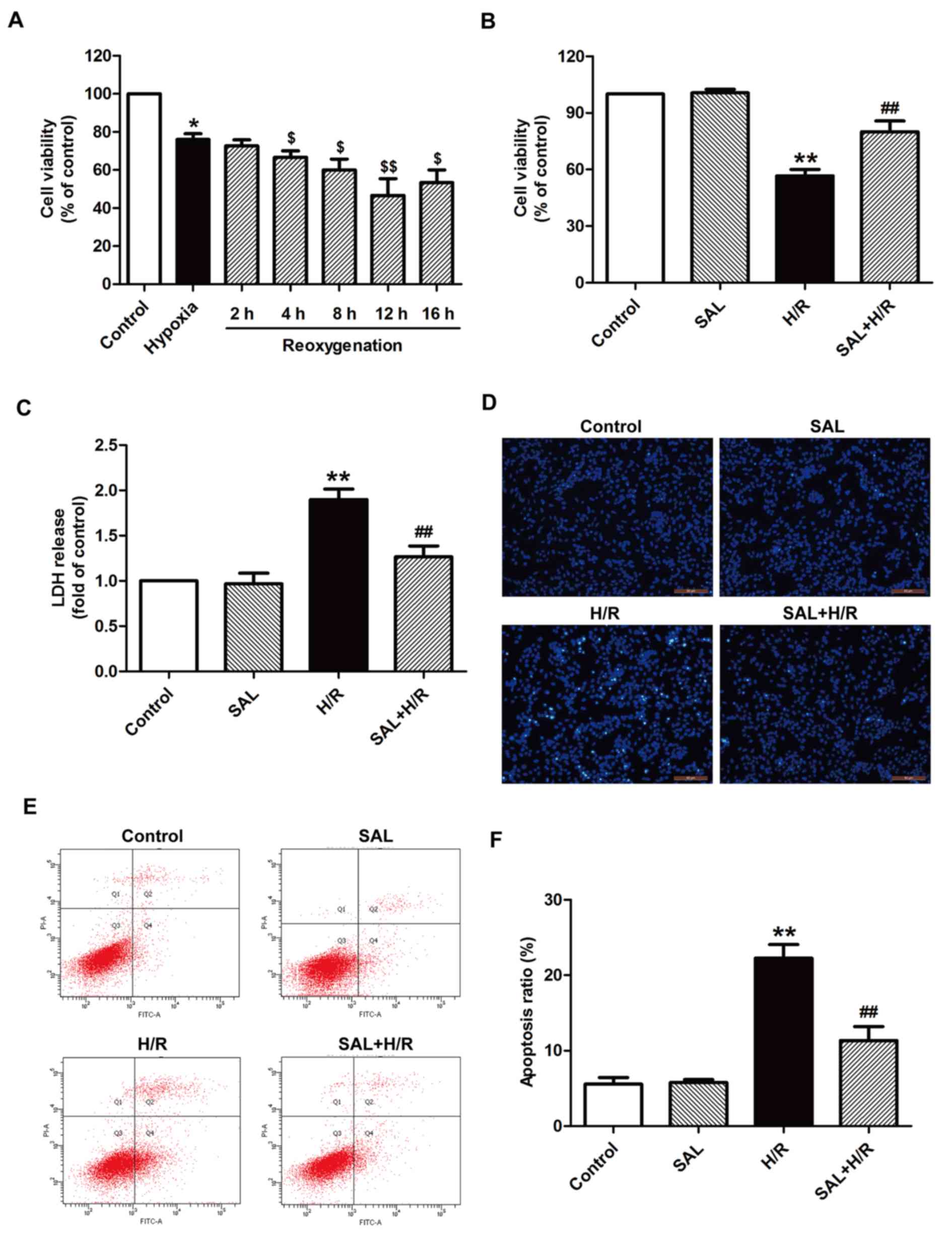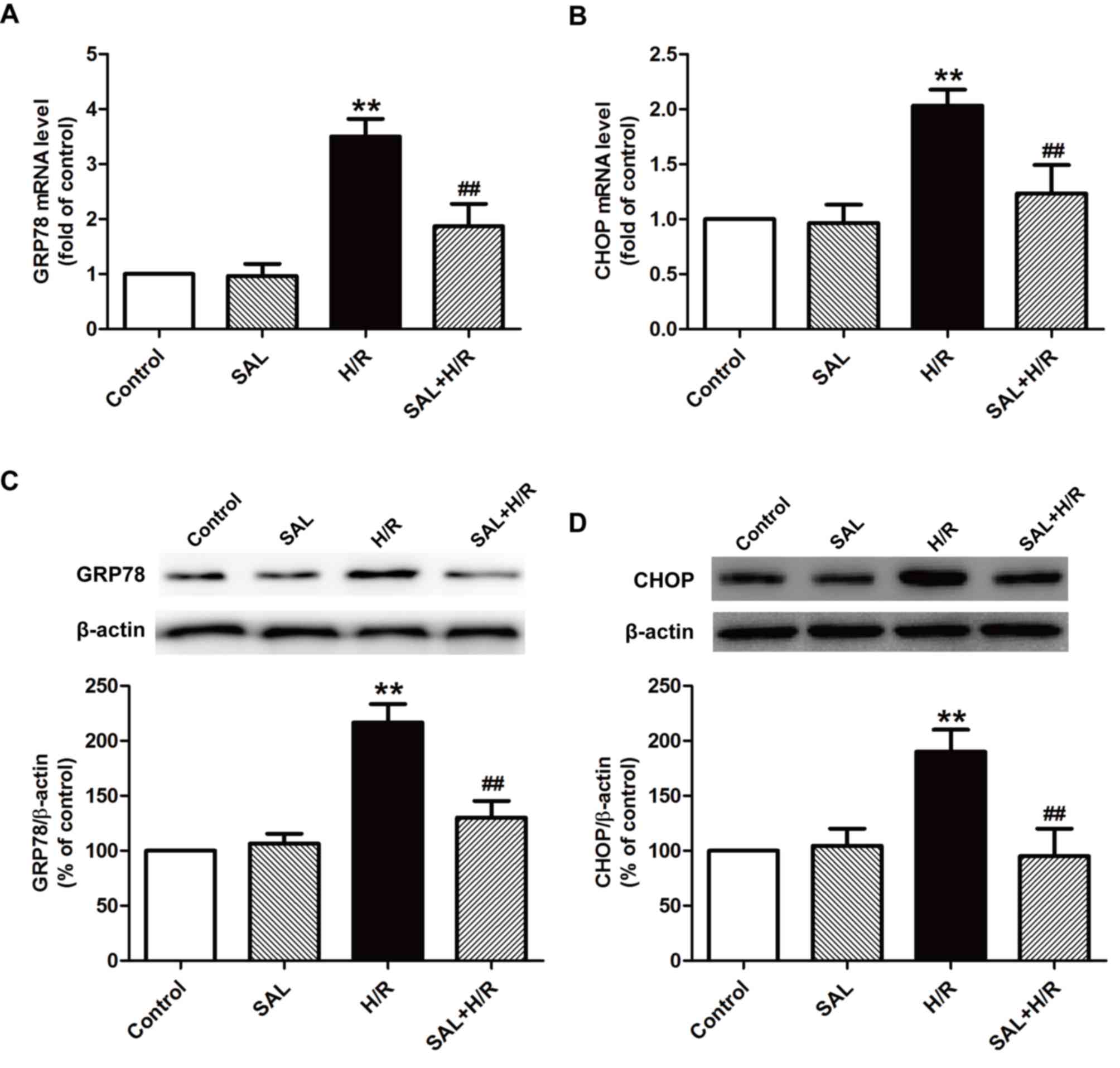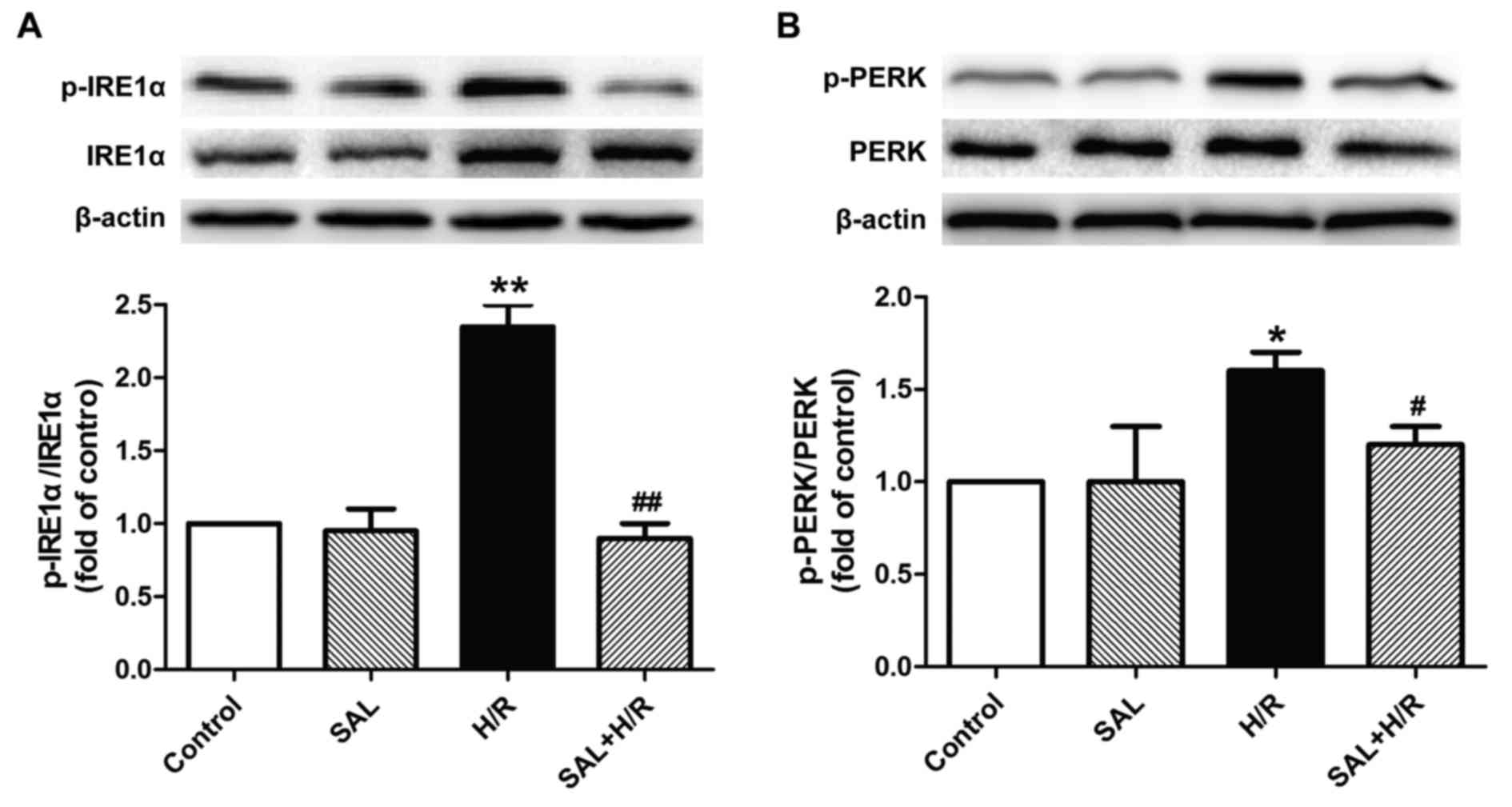|
1
|
Yellon DM and Hausenloy DJ: Myocardial
reperfusion injury. N Engl J Med. 357:1121–1135. 2007. View Article : Google Scholar : PubMed/NCBI
|
|
2
|
Levitsky S: Protecting the myocardial cell
during coronary revascularization. The William W. L. Glenn Lecture.
Circulation. 114 1 Suppl:I339–I343. 2006.
|
|
3
|
Kalogeris T, Baines CP, Krenz M and
Korthuis RJ: Cell biology of ischemia/reperfusion injury. Int Rev
Cell Mol Biol. 298:229–317. 2012. View Article : Google Scholar : PubMed/NCBI
|
|
4
|
Oerlemans MI, Koudstaal S, Chamuleau SA,
de Kleijn DP, Doevendans PA and Sluijter JP: Targeting cell death
in the reperfused heart: Pharmacological approaches for
cardioprotection. Int J Cardiol. 165:410–422. 2013. View Article : Google Scholar : PubMed/NCBI
|
|
5
|
Biwer LA and Isakson BE: Endoplasmic
reticulum-mediated signalling in cellular microdomains. Acta
Physiol (Oxf). 219:162–175. 2017. View Article : Google Scholar : PubMed/NCBI
|
|
6
|
Shen X, Zhang K and Kaufman RJ: The
unfolded protein response-a stress signaling pathway of the
endoplasmic reticulum. J Chem Neuroanat. 28:79–92. 2004. View Article : Google Scholar : PubMed/NCBI
|
|
7
|
Xu C, Bailly-Maitre B and Reed JC:
Endoplasmic reticulum stress: Cell life and death decisions. J Clin
Invest. 115:2656–2664. 2005. View
Article : Google Scholar : PubMed/NCBI
|
|
8
|
Bai S, Cheng L, Yang Y, Fan C, Zhao D, Qin
Z, Feng X, Zhao L, Ma J, Wang X, et al: C1q/TNF-related protein 9
protects diabetic rat heart against ischemia reperfusion injury:
Role of endoplasmic reticulum stress. Oxid Med Cell Longev.
2016:19020252016. View Article : Google Scholar : PubMed/NCBI
|
|
9
|
Wu H, Ye M, Yang J and Ding J: Modulating
endoplasmic reticulum stress to alleviate myocardial ischemia and
reperfusion injury from basic research to clinical practice: A long
way to go. Int J Cardiol. 223:630–631. 2016. View Article : Google Scholar : PubMed/NCBI
|
|
10
|
Yu L, Li S, Tang X, Li Z, Zhang J, Xue X,
Han J, Liu Y, Zhang Y, Zhang Y, et al: Diallyl trisulfide
ameliorates myocardial ischemia-reperfusion injury by reducing
oxidative stress and endoplasmic reticulum stress-mediated
apoptosis in type 1 diabetic rats: role of SIRT1 activation.
Apoptosis. 22:942–954. 2017. View Article : Google Scholar : PubMed/NCBI
|
|
11
|
Ron D and Hubbard SR: How IRE1 reacts to
ER stress. Cell. 132:24–26. 2008. View Article : Google Scholar : PubMed/NCBI
|
|
12
|
Ghosh AP, Klocke BJ, Ballestas ME and Roth
K: CHOP potentially co-operates with FOXO3a in neuronal cells to
regulate PUMA and BIM expression in response to ER stress. PLoS
One. 7:e395862012. View Article : Google Scholar : PubMed/NCBI
|
|
13
|
Toth A, Nickson P, Mandl A, Bannister ML,
Toth K and Erhardt P: Endoplasmic reticulum stress as a novel
therapeutic target in heart diseases. Cardiovasc Hematol Disord
Drug Targets. 7:205–218. 2007. View Article : Google Scholar : PubMed/NCBI
|
|
14
|
Lan X, Chang K, Zeng L, Liu X, Qiu F,
Zheng W, Quan H, Liao Z, Chen M, Huang W, et al: Engineering
salidroside biosynthetic pathway in hairy root cultures of Rhodiola
crenulata based on metabolic characterization of tyrosine
decarboxylase. PLoS One. 8:e754592013. View Article : Google Scholar : PubMed/NCBI
|
|
15
|
Guan S, Feng H, Song B, Guo W, Xiong Y,
Huang G, Zhong W, Huo M, Chen N, Lu J and Deng X: Salidroside
attenuates LPS-induced pro-inflammatory cytokine responses and
improves survival in murine endotoxemia. Int Immunopharmacol.
11:2194–2199. 2011. View Article : Google Scholar : PubMed/NCBI
|
|
16
|
Ming DS, Hillhouse BJ, Guns ES, Eberding
A, Xie S, Vimalanathan S and Towers GH: Bioactive compounds from
Rhodiola rosea (Crassulaceae). Phytother Res. 19:740–743. 2005.
View Article : Google Scholar : PubMed/NCBI
|
|
17
|
Xing S, Yang X, Li W, Bian F, Wu D, Chi J,
Xu G, Zhang Y and Jin S: Salidroside stimulates mitochondrial
biogenesis and protects against H2O2-induced
endothelial dysfunction. Oxid Med Cell Longev. 2014:9048342014.
View Article : Google Scholar : PubMed/NCBI
|
|
18
|
Zhu L, Wei T, Chang X, He H, Gao J, Wen Z
and Yan T: Effects of salidroside on myocardial injury in vivo in
vitro via regulation of Nox/NF-κB/AP1 pathway. Inflammation.
38:1589–1598. 2015. View Article : Google Scholar : PubMed/NCBI
|
|
19
|
Zhu L, Wei T, Gao J, Chang X, He H, Luo F,
Zhou R, Ma C, Liu Y and Yan T: The cardioprotective effect of
salidroside against myocardial ischemia reperfusion injury in rats
by inhibiting apoptosis and inflammation. Apoptosis. 20:1433–1443.
2015. View Article : Google Scholar : PubMed/NCBI
|
|
20
|
Zhu L, Jia F, Wei J, Yu Y, Yu T, Wang Y,
Sun J and Luo G: Salidroside protects against homocysteine-induced
injury in human umbilical vein endothelial cells via the regulation
of endoplasmic reticulum stress. Cardiovasc Ther. 35:33–39. 2017.
View Article : Google Scholar : PubMed/NCBI
|
|
21
|
Kim Y, Park M, Boghossian S and York DA:
Three weeks voluntary running wheel exercise increases endoplasmic
reticulum stress in the brain of mice. Brain Res. 1317:13–23. 2010.
View Article : Google Scholar : PubMed/NCBI
|
|
22
|
Martindale JJ, Fernandez R, Thuerauf D,
Whittaker R, Gude N, Sussman MA and Glembotski CC: Endoplasmic
reticulum stress gene induction and protection from
ischemia/reperfusion injury in the hearts of transgenic mice with a
tamoxifen-regulated form of ATF6. Circ Res. 98:1186–1193. 2006.
View Article : Google Scholar : PubMed/NCBI
|
|
23
|
Pierre N, Deldicque L, Barbé C, Naslain D,
Cani PD and Francaux M: Toll-like receptor 4 knockout mice are
protected against endoplasmic reticulum stress induced by a
high-fat diet. PLoS One. 8:e650612013. View Article : Google Scholar : PubMed/NCBI
|
|
24
|
Livak KJ and Schmittgen TD: Analysis of
relative gene expression data using real-time quantitative PCR and
the 2(-Delta Delta C(T)) method. Methods. 25:402–408. 2001.
View Article : Google Scholar : PubMed/NCBI
|
|
25
|
Groenendyk J, Sreenivasaiah PK, Kim DH,
Agellon LB and Michalak M: Biology of endoplasmic reticulum stress
in the heart. Circ Res. 107:1185–1197. 2010. View Article : Google Scholar : PubMed/NCBI
|
|
26
|
Miyazaki Y, Kaikita K, Endo M, Horio E,
Miura M, Tsujita K, Hokimoto S, Yamamuro M, Iwawaki T, Gotoh T, et
al: C/EBP homologous protein deficiency attenuates myocardial
reperfusion injury by inhibiting myocardial apoptosis and
inflammation. Arterioscler Thromb Vasc Biol. 31:1124–1132. 2011.
View Article : Google Scholar : PubMed/NCBI
|
|
27
|
Szegezdi E, Logue SE, Gorman AM and Samali
A: Mediators of endoplasmic reticulum stress-induced apoptosis.
EMBO Rep. 7:880–885. 2006. View Article : Google Scholar : PubMed/NCBI
|
|
28
|
Minamino T, Komuro I and Kitakaze M:
Endoplasmic reticulum stress as a therapeutic target in
cardiovascular disease. Circ Res. 107:1071–1082. 2010. View Article : Google Scholar : PubMed/NCBI
|
|
29
|
Xu MC, Shi HM, Gao XF and Wang H:
Salidroside attenuates myocardial ischemia-reperfusion injury via
PI3K/Akt signaling pathway. J Asian Nat Prod Res. 15:244–252. 2013.
View Article : Google Scholar : PubMed/NCBI
|
|
30
|
Grech-Baran M, Sykłowska-Baranek K and
Pietrosiuk A: Biotechnological approaches to enhance salidroside,
rosin and its derivatives production in selected Rhodiola spp. in
vitro cultures. Phytochem Rev. 14:657–674. 2015. View Article : Google Scholar : PubMed/NCBI
|
|
31
|
Vidavalur R, Swarnakar S, Thirunavukkarasu
M, Samuel SM and Maulik N: Ex vivo and in vivo approaches to study
mechanisms of cardioprotection targeting ischemia/reperfusion (i/r)
injury: useful techniques for cardiovascular drug discovery. Curr
Drug Discov Technol. 5:269–278. 2008. View Article : Google Scholar : PubMed/NCBI
|
|
32
|
Lai MC, Lin JG, Pai PY, Lai MH, Lin YM,
Yeh YL, Cheng SM, Liu YF, Huang CY and Lee SD: Protective effect of
salidroside on cardiac apoptosis in mice with chronic intermittent
hypoxia. Int J Cardiol. 174:565–573. 2014. View Article : Google Scholar : PubMed/NCBI
|
|
33
|
Liu XH, Zhang ZY, Sun S and Wu XD:
Ischemic postconditioning protects myocardium from
ischemia/reperfusion injury through attenuating endoplasmic
reticulum stress. Shock. 30:422–427. 2008. View Article : Google Scholar : PubMed/NCBI
|
|
34
|
Avila MF, Cabezas R, Torrente D, Gonzalez
J, Morales L, Alvarez L, Capani F and Barreto GE: Novel
interactions of GRP78: UPR and estrogen responses in the brain.
Cell Biol Int. 37:521–532. 2013. View Article : Google Scholar : PubMed/NCBI
|
|
35
|
Chiribau CB, Gaccioli F, Huang CC, Yuan CL
and Hatzoglou M: Molecular symbiosis of CHOP and C/EBP beta isoform
LIP contributes to endoplasmic reticulum stress-induced apoptosis.
Mol Cell Biol. 30:3722–3731. 2010. View Article : Google Scholar : PubMed/NCBI
|
|
36
|
Tao K, Wang B, Feng D, Zhang W, Lu F, Lai
J, Huang L, Nie T and Yang Q: Salidroside protects against
6-hydroxydopamine-induced cytotoxicity by attenuating ER stress.
Neurosci Bull. 32:61–69. 2016. View Article : Google Scholar : PubMed/NCBI
|
|
37
|
Zhang GG, Cai HQ, Li YH, Sui YB, Zhang JS,
Chang JR, Ning M, Wu Y, Tang CS, Qi YF and Yin XH: Ghrelin protects
heart against ERS-induced injury and apoptosis by activating
AMP-activated protein kinase. Peptides. 48:156–165. 2013.
View Article : Google Scholar : PubMed/NCBI
|
|
38
|
Zhong H, Xin H, Wu LX and Zhu Y:
Salidroside attenuates apoptosis in ischemic cardiomyocytes: A
mechanism through a mitochondria-dependent pathway. J Pharmacol
Sci. 114:399–408. 2010. View Article : Google Scholar : PubMed/NCBI
|
|
39
|
Fonseca AC, Ferreiro E, Oliveira CR,
Cardoso SM and Pereira CF: Activation of the endoplasmic reticulum
stress response by the amyloid-beta 1–40 peptide in brain
endothelial cells. Biochim Biophys Acta. 1832:2191–2203. 2013.
View Article : Google Scholar : PubMed/NCBI
|
|
40
|
Zhu XY, Zhang ZL, Li P, Liang WY, Feng XR
and Liu ML: Shenyuan, an extract of American Ginseng and Corydalis
Tuber formula, attenuates cardiomyocyte apoptosis via inhibition of
endoplasmic reticulum stress and oxidative stress in a porcine
model of acute myocardial infarction. J Ethnopharmacol.
150:672–681. 2013. View Article : Google Scholar : PubMed/NCBI
|
|
41
|
Cui W, Li J, Ron D and Sha B: The
structure of the PERK kinase domain suggests the mechanism for its
activation. Acta Crystallogr D Biol Crystallogr. 67:423–428. 2011.
View Article : Google Scholar : PubMed/NCBI
|
|
42
|
Kimata Y, Ishiwata-Kimata Y, Ito T, Hirata
A, Suzuki T, Oikawa D, Takeuchi M and Kohno K: Two regulatory steps
of ER-stress sensor Ire1 involving its cluster formation and
interaction with unfolded proteins. J Cell Biol. 179:75–86. 2007.
View Article : Google Scholar : PubMed/NCBI
|
|
43
|
Harding HP, Zhang Y, Bertolotti A, Zeng H
and Ron D: Perk is essential for translational regulation and cell
survival during the unfolded protein response. Mol Cell. 5:897–904.
2000. View Article : Google Scholar : PubMed/NCBI
|
|
44
|
Nishitoh H, Matsuzawa A, Tobiume K,
Saegusa K, Takeda K, Inoue K, Hori S, Kakizuka A and Ichijo H: ASK1
is essential for endoplasmic reticulum stress-induced neuronal cell
death triggered by expanded polyglutamine repeats. Genes Dev.
16:1345–1355. 2002. View Article : Google Scholar : PubMed/NCBI
|
|
45
|
Urano F, Wang X, Bertolotti A, Zhang Y,
Chung P, Harding HP and Ron D: Coupling of stress in the ER to
activation of JNK protein kinases by transmembrane protein kinase
IRE1. Science. 287:664–666. 2000. View Article : Google Scholar : PubMed/NCBI
|
|
46
|
Yu L, Li B, Zhang M, Jin Z, Duan W, Zhao
G, Yang Y, Liu Z, Chen W, Wang S, et al: Melatonin reduces
PERK-eIF2α-ATF4-mediated endoplasmic reticulum stress during
myocardial ischemia-reperfusion injury: role of RISK and SAFE
pathways interaction. Apoptosis. 21:809–824. 2016. View Article : Google Scholar : PubMed/NCBI
|
|
47
|
Wang J, Hu X and Jiang H: ERS-PERK
signaling pathway-mediated Nrf2/ARE-HO-1 axis: A novel therapeutic
target for attenuating myocardial ischemia and reperfusion injury.
Int J Cardiol. 203:779–780. 2016. View Article : Google Scholar : PubMed/NCBI
|
|
48
|
Chen M, Cai H, Yu C, Wu P, Fu Y, Xu X, Fan
R, Xu C, Chen Y, Wang L and Huang X: Salidroside exerts protective
effects against chronic hypoxia-induced pulmonary arterial
hypertension via AMPKα1-dependent pathways. Am J Transl Res.
8:12–27. 2016.PubMed/NCBI
|
|
49
|
Barhwal K, Das SK, Kumar A, Hota SK and
Srivastava RB: Insulin receptor A and Sirtuin 1 synergistically
improve learning and spatial memory following chronic salidroside
treatment during hypoxia. J Neurochem. 135:332–346. 2015.
View Article : Google Scholar : PubMed/NCBI
|













